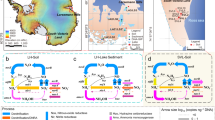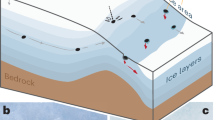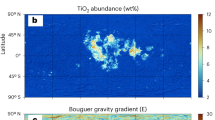Abstract
The Great Oxidation Event following the end of the Archaean eon (~2.4 Ga) was a profound turning point in the history of Earth and life, but the relative importance of various contributing factors remains an intriguing puzzle. Controls on methane flux to the atmosphere were of particular consequence; too much methane would have inhibited a persistent rise of O2, but too little may have plunged Earth into severe and prolonged ice ages. Here, we document a shift in the weathering reactions controlling the ocean-bound flux of nickel—an essential micronutrient for the organisms that produced methane in Precambrian oceans—by applying Ni stable isotope analysis to Mesoarchaean and Palaeoproterozoic glacial sediments. Although Ni flux to the ocean dropped dramatically as Ni content of the continental crust decreased, the onset of sulfide weathering delivered a small, but vital, flux of Ni to the oceans, sustaining sufficient methane production to prevent a permanent icehouse, while allowing O2 to rise.
This is a preview of subscription content, access via your institution
Access options
Access Nature and 54 other Nature Portfolio journals
Get Nature+, our best-value online-access subscription
$29.99 / 30 days
cancel any time
Subscribe to this journal
Receive 12 print issues and online access
$259.00 per year
only $21.58 per issue
Buy this article
- Purchase on Springer Link
- Instant access to full article PDF
Prices may be subject to local taxes which are calculated during checkout



Similar content being viewed by others
Data availability
All data supporting the findings of this study are available within the main text, figures and Supplementary Information files.
References
Holland, H. D. The oxygenation of the atmosphere and oceans. Phil. Trans. R. Soc. Lond. B 361, 903–915 (2006).
Lyons, T. W., Reinhard, C. T. & Planavsky, N. J. The rise of oxygen in Earth’s early ocean and atmosphere. Nature 506, 307–315 (2014).
Farquhar, J., Bao, H. & Thiemens, M. J. S. Atmospheric influence of Earth’s earliest sulfur cycle. Science 289, 756–758 (2000).
Philippot, P. et al. Globally asynchronous sulphur isotope signals require re-definition of the Great Oxidation Event. Nat. Commun. 9, 2245 (2018).
Anbar, A. D. et al. A whiff of oxygen before the Great Oxidation Event? Science 317, 1903–1906 (2007).
Crowe, S. A. et al. Atmospheric oxygenation three billion years ago. Nature 501, 535–538 (2013).
Reinhard, C. T., Raiswell, R., Scott, C., Anbar, A. D. & Lyons, T. W. A late Archean sulfidic sea stimulated by early oxidative weathering of the continents. Science 326, 713–716 (2009).
Catling, D. C., Zahnle, K. J. & McKay, C. P. Biogenic methane, hydrogen escape, and the irreversible oxidation of early Earth. Science 293, 839–843 (2001).
Keller, C. B. & Schoene, B. Statistical geochemistry reveals disruption in secular lithospheric evolution about 2.5 Gyr ago. Nature 485, 490–493 (2012).
Lee, C.-T. A. et al. Two-step rise of atmospheric oxygen linked to the growth of continents. Nat. Geosci. 9, 417–424 (2016).
Smit, M. A. & Mezger, K. Earth’s early O2 cycle suppressed by primitive continents. Nat. Geosci. 10, 788–792 (2017).
Tang, M., Chen, K. & Rudnick, R. L. Archean upper crust transition from mafic to felsic marks the onset of plate tectonics. Science 351, 372–375 (2016).
Kump, L. R. & Barley, M. E. Increased subaerial volcanism and the rise of atmospheric oxygen 2.5 billion years ago. Nature 448, 1033–1036 (2007).
Gaillard, F., Scaillet, B. & Arndt, N. T. Atmospheric oxygenation caused by a change in volcanic degassing pressure. Nature 478, 229–232 (2011).
Buick, R. When did oxygenic photosynthesis evolve? Phil. Trans. R. Soc. Lond. B 363, 2731–2743 (2008).
Planavsky, N. J. et al. Evidence for oxygenic photosynthesis half a billion years before the Great Oxidation Event. Nat. Geosci. 7, 283–286 (2014).
Lalonde, S. V. & Konhauser, K. O. Benthic perspective on Earth’s oldest evidence for oxygenic photosynthesis. Proc. Natl Acad. Sci. USA 112, 995–1000 (2015).
Kopp, R. E., Kirschvink, J. L., Hilburn, I. A. & Nash, C. Z. The Paleoproterozoic snowball Earth: a climate disaster triggered by the evolution of oxygenic photosynthesis. Proc. Natl Acad. Sci. USA 102, 11131–11136 (2005).
Kasting, J. F. Methane and climate during the Precambrian era. Precambrian Res. 137, 119–129 (2005).
Zahnle, K., Claire, M. & Catling, D. The loss of mass-independent fractionation in sulfur due to a Palaeoproterozoic collapse of atmospheric methane. Geobiology 4, 271–283 (2006).
Evans, D., Beukes, N. & Kirschvink, J. Low-latitude glaciation in the Palaeoproterozoic era. Nature 386, 262–266 (1997).
Thauer, R. K. Biochemistry of methanogenesis: a tribute to Marjory Stephenson: 1998 Marjory Stephenson prize lecture. Microbiology 144, 2377–2406 (1998).
Konhauser, K. O. et al. Oceanic nickel depletion and a methanogen famine before the Great Oxidation Event. Nature 458, 750–753 (2009).
Konhauser, K. O. et al. The Archean nickel famine revisited. Astrobiology 15, 804–815 (2015).
Glass, J. & Dupont, C. The Biological Chemistry of Nickel 12–26 (Royal Society of Chemistry, 2017).
Large, R. R. et al. Trace element content of sedimentary pyrite as a new proxy for deep-time ocean–atmosphere evolution. Earth Planet. Sci. Lett. 389, 209–220 (2014).
Gallagher, M., Turner, E. & Kamber, B. In situ trace metal analysis of Neoarchaean—Ordovician shallow-marine microbial-carbonate-hosted pyrites. Geobiology 13, 316–339 (2015).
Condie, K. C. Chemical composition and evolution of the upper continental crust: contrasting results from surface samples and shales. Chem. Geol. 104, 1–37 (1993).
Taylor, S. & McLennan, S. The Continental Crust: Its Evolution Composition (Blackwell, London, 1985).
Greber, N. D. et al. Titanium isotopic evidence for felsic crust and plate tectonics 3.5 billion years ago. Science 357, 1271–1274 (2017).
Gaschnig, R. M. et al. Compositional evolution of the upper continental crust through time, as constrained by ancient glacial diamictites. Geochim. Cosmochim. Acta 186, 316–343 (2016).
Li, S., Gaschnig, R. M. & Rudnick, R. L. Insights into chemical weathering of the upper continental crust from the geochemistry of ancient glacial diamictites. Geochim. Cosmochim. Acta 176, 96–117 (2016).
Gueguen, B., Rouxel, O., Ponzevera, E., Bekker, A. & Fouquet, Y. Nickel isotope variations in terrestrial silicate rocks and geological reference materials measured by MC-ICP-MS. Geostand. Geoanal. Res. 37, 297–317 (2013).
Hofmann, A. et al. Comparing orthomagmatic and hydrothermal mineralization models for komatiite-hosted nickel deposits in Zimbabwe using multiple-sulfur, iron, and nickel isotope data. Miner. Deposita 49, 75–100 (2014).
Cameron, V., Vance, D., Archer, C. & House, C. H. A biomarker based on the stable isotopes of nickel. Proc. Natl Acad. Sci. USA 106, 10944–10948 (2009).
Nesbitt, H. & Young, G. Early Proterozoic climates and plate motions inferred from major element chemistry of lutites. Nature 299, 715–717 (1982).
Spivak-Birndorf, L. J., Wang, S.-J., Bish, D. L. & Wasylenki, L. E. Nickel isotope fractionation during continental weathering. Chem. Geol. 476, 316–326 (2017).
Johnson, J. E., Gerpheide, A., Lamb, M. P. & Fischer, W. W. O2 constraints from Paleoproterozoic detrital pyrite and uraninite. Geol. Soc. Am. Bull. 126, 813–830 (2014).
Konhauser, K. O. et al. Aerobic bacterial pyrite oxidation and acid rock drainage during the Great Oxidation Event. Nature 478, 369–373 (2011).
Holland, H. D. The Chemical Evolution of the Atmosphere and Oceans (Princeton Univ. Press, 1984).
Stüeken, E. E., Catling, D. C. & Buick, R. Contributions to late Archaean sulphur cycling by life on land. Nat. Geosci. 5, 722–725 (2012).
Lovley, D. R. & Klug, M. J. Sulfate reducers can outcompete methanogens at freshwater sulfate concentrations. Appl. Env. Microbiol. 45, 187–192 (1983).
Catling, D., Claire, M. & Zahnle, K. Anaerobic methanotrophy and the rise of atmospheric oxygen. Phil. Trans. A Math. Phys. Eng. Sci. 365, 1867–1888 (2007).
Gumsley, A. P. et al. Timing and tempo of the Great Oxidation Event. Proc. Natl Acad. Sci. USA 114, 1811–1816 (2017).
Ulrich, T., Long, D., Kamber, B. & Whitehouse, M. In situ trace element and sulfur isotope analysis of pyrite in a Paleoproterozoic gold placer deposit, Pardo and Clement Townships, Ontario, Canada. Econ. Geol. 106, 667–686 (2011).
Wang, S.-J. & Wasylenki, L. E. Experimental constraints on reconstruction of Archean seawater Ni isotopic composition from banded iron formations. Geochim. Cosmochim. Acta 206, 137–150 (2017).
Wasylenki, L. E., Howe, H. D., Spivak-Birndorf, L. J. & Bish, D. L. Ni isotope fractionation during sorption to ferrihydrite: implications for Ni in banded iron formations. Chem. Geol. 400, 56–64 (2015).
Cameron, V. & Vance, D. Heavy nickel isotope compositions in rivers and the oceans. Geochim. Cosmochim. Acta 128, 195–211 (2014).
Ratié, G. et al. Nickel isotope fractionation during tropical weathering of ultramafic rocks. Chem. Geol. 402, 68–76 (2015).
Coetzee, L., Beukes, N., Gutzmer, J. & Kakegawa, T. Links of organic carbon cycling and burial to depositional depth gradients and establishment of a snowball Earth at 2.3 Ga. Evidence from the Timeball Hill Formation, Transvaal Supergroup, South Africa. S. Afr. J. Geol. 109, 109–122 (2006).
Acknowledgements
We thank W. Maier and E. Ripley for providing the komatiite samples. The research was supported by the National Science Foundation EAR-1424676 to L.E.W. and EAR-1321954 to R.L.R. and R.M.G.
Author information
Authors and Affiliations
Contributions
S.-J.W. conceived the project, conducted the experimental analyses, interpreted the data and drafted the manuscript. L.E.W. provided funding and facilities, augmented the data interpretation and substantially edited the manuscript. R.L.R., R.M.G. and H.W. provided samples and participated in discussion of the interpretations and manuscript editing.
Corresponding author
Ethics declarations
Competing interests
The authors declare no competing interests.
Additional information
Publisher’s note: Springer Nature remains neutral with regard to jurisdictional claims in published maps and institutional affiliations.
Supplementary information
Supplementary information
Supplementary information, Supplementary Figs 1–6 and Tables 1–3
Rights and permissions
About this article
Cite this article
Wang, SJ., Rudnick, R.L., Gaschnig, R.M. et al. Methanogenesis sustained by sulfide weathering during the Great Oxidation Event. Nat. Geosci. 12, 296–300 (2019). https://doi.org/10.1038/s41561-019-0320-z
Received:
Accepted:
Published:
Issue Date:
DOI: https://doi.org/10.1038/s41561-019-0320-z
This article is cited by
-
The biogeochemical balance of oceanic nickel cycling
Nature Geoscience (2022)
-
Mechanisms and climatic-ecological effects of the Great Oxidation Event in the early Proterozoic
Science China Earth Sciences (2022)
-
Active methanogenesis during the melting of Marinoan snowball Earth
Nature Communications (2021)
-
Nickel isotopes link Siberian Traps aerosol particles to the end-Permian mass extinction
Nature Communications (2021)
-
Tracing the formation and differentiation of the Earth by non-traditional stable isotopes
Science China Earth Sciences (2019)



